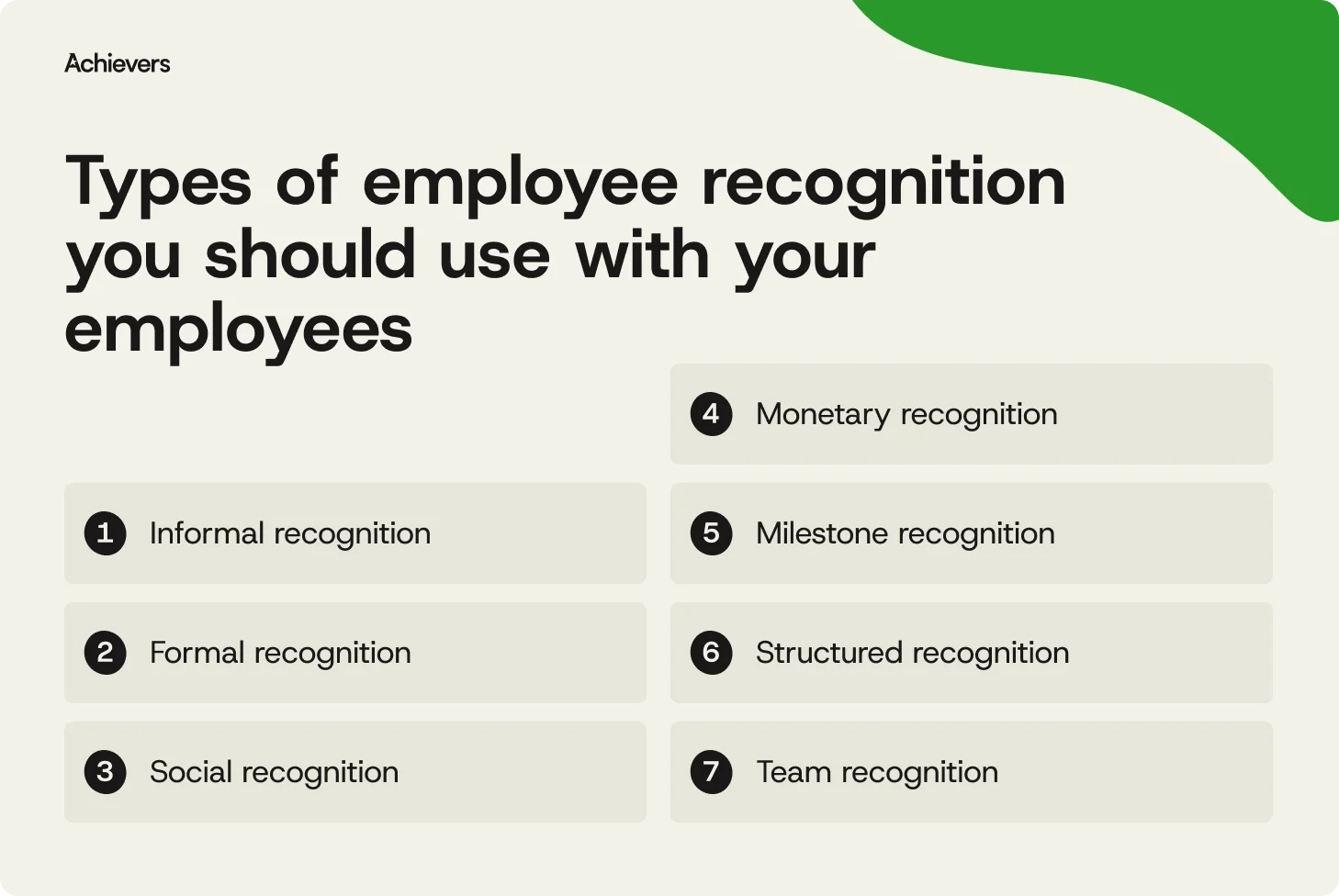Table of contents
Create a culture that means business™
Schedule a demo with an Achievers solution expert today.
There was a time when employee recognition meant a quick “nice job” in the hallway or a framed certificate every five years. It was well-meaning — but let’s be honest, not exactly inspiring.
Today’s employees want more than a token gesture. They want to feel genuinely seen, heard, and appreciated in ways that reflect who they are and how they work — whether that’s remote, in-office, or hybrid.
Recognition isn’t a once-in-a-while activity. It’s a powerful, everyday tool for shaping culture, boosting engagement, and reminding people their work actually matters. And yes, it can be done better.
The 7 types of employee recognition (and how to use them well)
Recognition isn’t one-size-fits-all. To truly motivate and engage employees, you need a mix of approaches that match different moments and personalities. From quick thank-you’s to milestone celebrations, here are the key types of recognition every workplace should have in its toolkit:

1. Informal recognition
Unplanned, in-the-moment appreciation. It’s the thank-you note. The shout-out in a team meeting. The “you crushed it” message in chat. Small? Sure. But stack enough of these up, and you’ve got a culture where people feel genuinely seen.
Just because it’s informal doesn’t mean your company should take a back seat. Give employees the tools to recognize anytime, anywhere — and consider spotlighting your top givers and receivers. Recognition doesn’t always need a stage, but it helps to shine a light every now and then.
Examples:
- Verbal praise in meetings
- Quick, thoughtful thank-you notes
- Private one-on-one appreciation
- Public shout-outs on team calls
- Social media recognition
2. Formal recognition
This is the classic stuff — years of service awards, performance bonuses, title changes. Formal recognition sets the foundation. It gives people something to strive for and ensures big wins get the moment they deserve.
While it’s not enough on its own, when paired with frequent, everyday recognition, formal programs help shape a high-performance culture. They say, “This matters. You matter.” And that message lands.
Examples:
- Employee of the month/year
- Promotions and title changes
- Formal letters or certificates of achievement
- Performance-based bonuses
- Merit-based salary increases
3. Social recognition
Recognition that’s shared, liked, commented on, and maybe even emoji-reacted to. Social recognition makes appreciation visible — and contagious. The key? Giving employees an easy, engaging way to thank each other and celebrate great work.
Of course, it starts at the top. When leaders model what good recognition looks like, it becomes part of the culture. Make it interactive. Make it joyful. Just don’t make it optional.
Examples:
- Peer-to-peer recognition platforms
- Digital or physical recognition boards
- Employee spotlights in newsletters or intranet
- Hashtag campaigns to amplify appreciation
- Company-wide appreciation days or weeks
4. Monetary recognition
Let’s be honest — saying “thank you” feels good. Getting rewarded for it? Even better. Monetary recognition gives people tangible proof that their contributions matter. But that doesn’t mean it needs to be one-size-fits-all.
Points-based reward systems let employees choose the rewards that matter to them. It’s flexible, scalable, and far more exciting than another branded water bottle.
Examples:
- Performance or spot bonuses
- Profit sharing
- Gift cards
- Stock options or equity
- Points-based reward catalogs with wide variety
5. Milestone recognition
Work anniversaries. Project launches. Promotions. These moments matter — and employees remember how you respond to them. A thoughtful, personal touch can turn a routine milestone into something meaningful.
The trick? Keep it fresh. Involve employees in how they want to celebrate. A handwritten note or a quirky team tradition goes a lot further than you think.
Examples:
- Service anniversary gifts
- Celebrating onboarding completion
- Team events for project completions
- Recognizing safety or quality milestones
- Promotion celebrations
6. Structured recognition
Structured programs help recognition happen consistently and fairly. They create clarity around what’s valued and ensure recognition doesn’t depend on one manager’s memory (or mood).
When tied to performance goals, structured recognition also reinforces the behaviors that move the business forward. It’s strategy — with a smile.
Examples:
- Annual reviews with formal recognition built in
- Sales or innovation awards
- Certification completions
- Incentive programs tied to clear outcomes
- Nomination-based employee awards
7. Team recognition
Great work rarely happens in a vacuum. Team recognition celebrates collaboration, shared wins, and the messy, beautiful reality of working together.
It builds trust, promotes cross-functional appreciation, and reminds people that when one team wins, the whole company moves forward.
Examples:
- Team of the quarter awards
- Group outings or team-building perks
- Recognition letters to full teams
- Customized gifts or merch for the group
- Career development perks tied to team success
See what recognition types can really do
Whether it’s celebrating milestones, sharing social shout-outs, or rewarding with purpose — recognition is most powerful when it fits seamlessly into the way your people work. And let’s be honest: one-size-fits-all never really fits anyone.
That’s where Achievers comes in. Our recognition platform makes it easy (and actually enjoyable) to celebrate your people — wherever they are and however they work. With a mobile-friendly experience and a global rewards marketplace that’s, frankly, kind of impressive, we help turn appreciation into everyday action.



